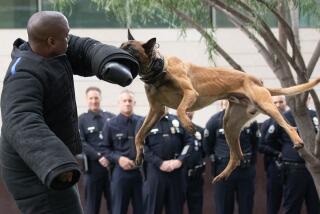Police Canines Get New Image: Bark Over Bite
- Share via
RIVERSIDE — On any given day, a 5 1/2-acre ranch known as Adlerhorst , German for “Eagle’s Nest,” is surrounded by dozens of police and sheriff’s patrol cars.
But the officers are not at the Riverside spread on a raid; they’ve come to buy and train their German shepherd dogs imported directly from Germany at a cost of $4,500 each.
Owner David Reaver has capitalized on a growing trend among law-enforcement agencies to use dogs to search for suspects, drugs and bombs, creating what he believes to be the largest private police dog school in the country.
The former electrical contractor has turned what was once a hobby into a $500,000-a-year business, selling more than 300 German shepherds to more than 60 law enforcement agencies across the nation.
Most in Southland
Most of those departments are in Southern California, including the Los Angeles Sheriff’s Department and police departments in Santa Monica, Huntington Beach, Anaheim, Santa Ana and San Diego.
Departments in Las Vegas and Albuquerque have also recently signed up.
One key to Reaver’s success is his selling of a new image of a less violent animal that uses its sense of smell and its bark--instead of its teeth--to stop suspects whenever possible.
“The training is geared toward very minimal force,” Reaver said. “Their first response is to tell us where the suspect is with a bark.”
The dog is taught to bite only if the handler gives the command, usually when the suspect tries to flee or attacks the handler or the dog.
Also important is Reaver’s sales pitch that the dogs will save budget-conscious departments money by performing certain tasks such as searches faster and more thoroughly than humans can.
“The dogs, while they are not perfect, save a lot of man-hours,” said Reaver, 47, who started his business in 1977.
“I can go into a police chief’s office and show him with facts and figures that a dog very easily pays for itself in the first year.”
The increase of illegal drug trafficking and bomb threats has helped create a demand for the dogs, who can detect sulfuric acid in concentrations of 1 to 10 million, or less than one drop in 100 gallons of water.
All of Reaver’s dogs--most of them males--are imported from Germany after undergoing a series of medical examinations and passing a tough training test.
Once in California, the dogs are matched with an officer who has agreed to be the dog’s partner for at least two years.
The pair attend daily training sessions for three weeks at the kennel, where half a dozen employees help lead classes in searching and attacking. All the commands are in German, the dogs’ first language.
Drug and bomb-sniffing classes are also offered for a select few dogs, although more departments are requesting the special training, Reaver said.
Replaces Problem Dogs
If the dogs develop serious behavioral or health problems, Reaver will replace them. Fewer than six of his 300 dogs have been retired early due to health problems; about 15 have been returned and resold for private use due to “inability to perform,” usually for “lack of motivation,” Reaver said.
Most dogs begin service at age 2 and continue until they are 8 or 10.
More to Read
Sign up for Essential California
The most important California stories and recommendations in your inbox every morning.
You may occasionally receive promotional content from the Los Angeles Times.










